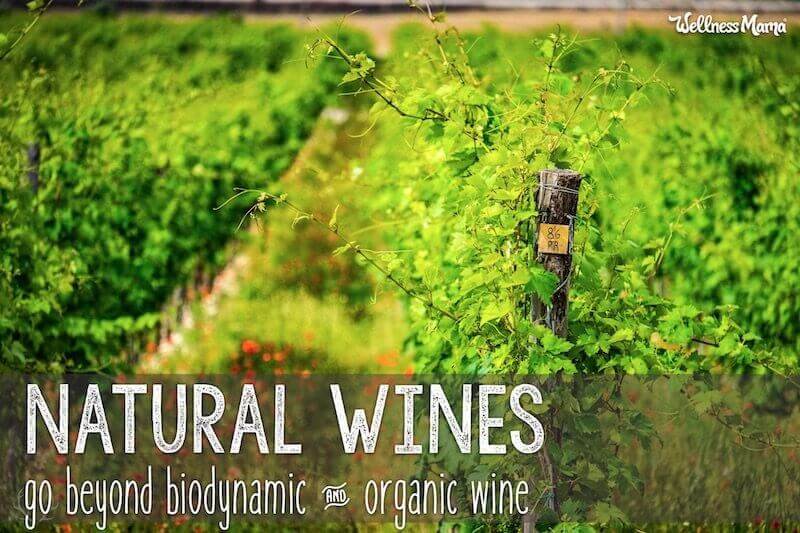In the food world, the label “natural” is unregulated and can appear on products that contain traces of pesticides, antibiotics, or other additives. For a long time, I assumed the same was the case with wine and that for the most part, all wine was “natural.” Right?
Turns out I was more than just a little bit off!
I took a trip to Europe to visit natural wine producers at their vineyards (maybe my favorite research I’ve ever done!). The trip was a rapid education into the vast differences that set natural wine apart from other types. I thought I already knew quite a bit about wine, but I was completely blown away by what I didn’t know! 
I wish I could take you to all the places I visited and show you the amazing attention to detail and work that goes into natural wines. That I could let you smell the humus in the soil and taste the fresh grapes. Show you the three generations of winemaking families all working together for months to make a wine they are so proud of.
Since I can’t, I’ll do my best to do it justice in words and show you in pictures.
Here’s what I learned:
What Is Natural Wine?
In short, natural wine is organic and biodynamic, but it is also so much more (or so much less, depending on how you look at it!). Not all organic and biodynamic wines are natural wines, so it’s important to understand the difference…
The natural wine movement is a small (and loosely organized) group of people who believe that the best wines are the ones that are manipulated the least.
In other words, truly natural wine has:
- nothing sprayed in the vineyard (even water most of the time)
- nothing added to the wine.
Natural wine is an unregulated term, so practices can vary from winemaker to winemaker. Just seeing the term “natural” used in wine marketing doesn’t guarantee these standards, especially in US-grown wines. I personally only buy wines that use stringent lab tests to ensure that all wines meet the “natural wine” criteria.
Natural Wine vs. Conventional Wines
Not all wines are natural… not even all organic wines. As I said, the term “natural” in wine-making denotes that nothing is added at any point in the process. So what might be used in other wines that don’t meet this standard?
Glad you asked (though you may not be after you read this list!):
- Commercial yeasts: Often the natural yeasts present on the grapes are killed off and a commercial yeast is used instead. Even organic wines can use commercial yeasts, and some commercial yeasts can contain GMO ingredients.
- Dyes: Ever think there might be dye in your wine? Dyes like Mega Purple are often added to wine to give it a bolder color. If your wine dyes your teeth red or purple, it likely has an added dye. Mega Purple is made by concentrating Rubired grapes into a thick and very color-rich liquid with 68% sugar!
- Sugar: More on this below, but I saw tests from some wines that contain more sugar than soda. This sugar can be natural (from cane or beet sugar) or added at the time of bottling. High sugar is a sign that the grapes were overly watered or that supplemental sugar was added.
- Sulfites: All wine contains traces of sulfites that naturally occur in grape skins and during fermentation. Some winemakers also add sulfur as a preservative and to kill certain unwanted bacteria in the wine. Wines labeled “low-sulfite” or “no-sulfites” have only naturally occurring sulfites.
- Pesticides: Non-organic wines often contain pesticide residue. Think about this… if you buy conventional produce, you at least wash or peel it before eating. Grapes go straight into a fermentation vessel, pesticides and all.
- Mold and Mycotoxins: These are more common in red wines, especially from humid areas. If you’re OK with white wine but red wine gives you a headache, it might be the mold/mycotoxins and not the sulfites. European winemakers must test for mold and mycotoxins but US wine makers are not required to.
- Filtering agents: You wouldn’t think you’d find animal ingredients in wine, but some wines use filtering agents like fish bladders and egg whites to filter the wine. Yep… sorry to tell you.
- Velcorin: The most dangerous additive on this list. Velcorin or dimethyl dicarbonate is a bacterial control agent added to many wines. It has to be added by specially licensed teams using hazmat suits under very strict procedures. No one is allowed to touch the wine for 24 hours after application and if you drank the wine during that time, you would die. Bad news!
The Microbiome of Natural Wine
I’ve visited many vineyards in the United States and now many in Europe as well. One difference was striking. In the US, the chemistry and yeast/bacterial balancing happen in a lab and in the fermentation vessels.
Natural wines, on the other hand, rely on the chemistry and microbiome in the vineyard. Nothing is done to the wine once it’s in the fermentation vessel.
In short, living vineyards + native yeasts = living natural wine that is in a class of its own.
Here’s what I mean…
Microbiome of the Vineyard
US vineyards are clean and manicured… and dead. There are typically no unwanted plants growing under the vines — a clue that they are sprayed with pesticides and other chemicals to keep away unwanted pests and plants.
In Europe, by contrast, many of the natural vineyards were teeming with other plants like herbs and flowers, beneficial insects, and snails. All of these things contribute to the bacterial balance in the vineyard and serve an important purpose.
Humus and Terroir
 I added two new words to my wine vocabulary in Europe and that I never heard in US vineyards: Humus and Terroir.
I added two new words to my wine vocabulary in Europe and that I never heard in US vineyards: Humus and Terroir.
Ever seen that gorgeous dark soil right under the top layer of leaves and twigs in a forest? Or smelled the fresh dirt when you’ve dug something up? You likely smelled humus, the dark organic material that forms when plants and animals decay and where the earthworms live. This important soil level also contains important nutrients for plants and nitrogen. Scientists think that this layer may help prevent disease in the soil and make it more fertile. It is also largely missing from many commercial farmlands.
Humus adds a depth of flavor to wine and natural winemakers spend a lot of time working on the health of the soil… and letting the grapes do their own thing.
Natural winemakers also had an intense focus on the quality of the soil and what they called “Terroir,” (a French word that literally translated means “earth” or “soil”). Terroir is basically the idea that the place (the vineyard) is reflected in the taste of the wine. Since natural winemakers don’t add anything to the wine to correct the bacterial balance or taste, they instead culture the soil to create minerality and taste.
In some of the wines we tasted, we could literally taste the vineyard we’d just visited in the flavor of the wine.
Native Yeasts and Living Wines
I was fascinated to learn that while all wines used to be made with their own native and natural yeasts, winemakers now kill off the native yeast and use a standardized commercial yeast for easier fermentation and a more standard taste.
The downside is that unwanted (and possibly beneficial) species of yeast and bacteria are killed off and only the commercial yeast remains. Think of it as the difference between a single strain probiotic and all of the trillions of bacteria present in the soil.
Natural wines are more complicated because they depend on the yeast that is naturally present on the skin of the grapes for fermentation. For this reason, natural wines can be less predictable and taste more complex.
One winemaker had identified literally thousands of bacteria present in wines. For this reason, natural wines are living wines and can be as different from some commercial wines as kombucha is from beer or soda.
Dry Farmed and Low Sugar Wines
The sugar content and irrigation practices also put natural wine in a class of its own. Many organic and biodynamic wines can still be very high in sugar and even high in alcohol. If you’ve heard the increasingly popular term “dry farmed” in reference to wine, this affects both the sugar and alcohol content.
Here’s why:
Watering grapes results in a higher yield and sweeter wine, which is the reason artificial irrigation became a common practice. Unfortunately, irrigation also teaches the grapes that their roots don’t have to grow as deep since the water is available near the surface of the soil.
Dry farmed (non-irrigated) vines send roots down to 30 feet or farther underground where they find more water, more minerals, and more micronutrients. This creates a lower sugar, lower alcohol, and more complex wine.
Low Alcohol in Natural Wines
Depending on why you like drinking wine (if you do), you may be wondering: “Why on earth would I want low-alcohol wine?”
I personally drink wine in moderation somewhat regularly because I enjoy it and I believe that in moderate amounts it can be very health-promoting. In fact, a 2007 study from Finland found that wine drinkers have a 34% lower mortality rate than beer or spirit drinkers. And people in every major Blue Zone (where people live to be 100+) consume wine regularly.
BUT…
Alcohol is toxic. In fact, Dry Farm Wines founder Todd White was emphatic about this when I interviewed him for the podcast.
However, we know that some things that are toxic in large doses can be beneficial in small doses. This concept is known as hormesis. It essentially means that the dose makes the poison (an important concept in homeopathic medicine).
For those of us who choose to approach alcohol consumption with a moderate approach rather than avoid it altogether, low alcohol wines can be a great solution. If they are natural wines, they contain less of the toxic element (alcohol) and more of the beneficial yeasts and bacteria, antioxidants, and beneficial phytochemicals that likely account for the plethora of research about the benefits of wine.
How to Find High Quality Natural Wine
I was surprised how few wines met the stringent criteria for true natural wine. I was traveling with some of the most knowledgeable people in the world about natural wines (and who run the largest natural wine distribution company in the world!).
We visited several wine fairs throughout France and Italy and I was shocked how few of the wines met their (very) strict criteria. I also saw (and tasted) firsthand the big difference between true natural wine and just organic or biodynamic wines. To even be considered, the wines had to:
- Dry farmed (not irrigated)
- Use native yeast from the vineyard with no commercial yeast added
- Have low alcohol content (12.5% or less)
- Be sugar-free (less than 1g/L)
- Use natural or biodynamic farming practices
- Come from grapes grown on old vines (35-100 years old)
If a wine met all of those criteria, then it got to the taste test. These guys are strict! They passed on a lot of wines that tasted perfectly wonderful to me!
If a wine passed their stringent taste test, they sent it to a lab for testing to confirm the above criteria. There they tested it for mold and mycotoxins, pesticide residue, and a lot of other stuff.
In other words, their wines get more lab testing than most humans do in a year.
And Now I’m a Wine Snob…
Don’t take this in the traditional sense… I haven’t made drinking wine into a hobby (even though I love mulled wine from time to time) and I don’t have enough experience to identify all of the notes, etc. (Although I’m pretty sure I was entertaining to watch as I tried in Europe!)
I am, however, picky when it comes to the sourcing of wine. Now that I understand just how important all of these factors are, I only choose natural wine to drink. If I have a choice between a regular organic wine that doesn’t meet the criteria and not drinking… I don’t drink.
The problem is that you can’t just walk into a normal wine store or restaurant and ask for a glass of natural wine. I’ve tried. Many people don’t understand the differences and believe, as I used to, that all wine is natural.
There are some general guidelines that help somewhat, such as:
- European wines are more likely to meet the natural wine criteria.
- Low alcohol wines are more likely to be made with a natural winemaking process.
- Biodynamic wines made from organic grapes typically have fewer additives and shouldn’t have pesticide residue.
But none of those is a surefire way to know a wine is natural. And I saw just how much work goes into identifying these wines.
Where I Buy (Natural) Wine
Now, I only buy lab-tested wines from Dry Farm Wines for so many reasons. I know the quality is there because of the stringent criteria and lab tests. But more than that, I know just how much heart and soul goes into these wines.
I know what it looks like to see three generations working together to create something amazing. And I’ve seen how the lives of these small family-owned wine growers change when they are able to sell these wines and share them with the world. And now, when I taste a sip of these wines, I can almost see and smell the vineyard where they were grown.
Chances are you won’t find these organically and biodynamically grown wines at a wine shop near you (or know how to identify them if they are), so I’ve worked out a special offer from Dry Farm Wines for Wellness Mama readers:
Get an extra bottle of wine for just a penny with any order at this link.
This article was medically reviewed by Dr. Scott Soerries, MD, Family Physician and Medical Director of SteadyMD. As always, this is not personal medical advice and we recommend that you talk with your doctor.
Are you a wine drinker? Have you tried natural wine? What differences have you noticed?


Leave a Reply